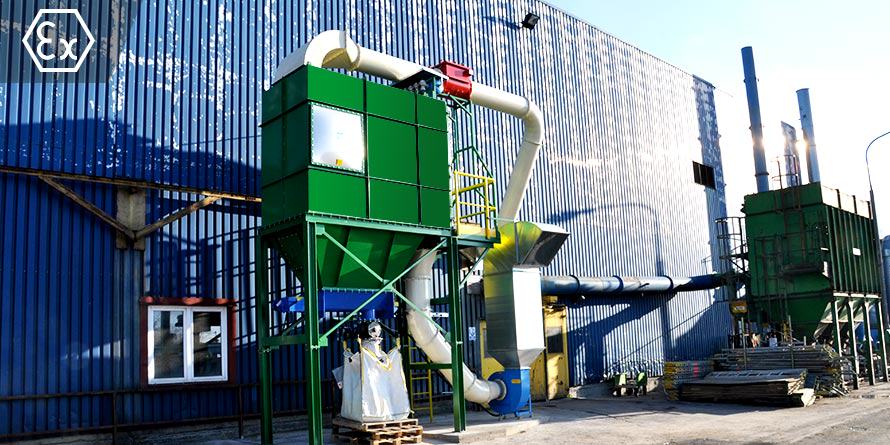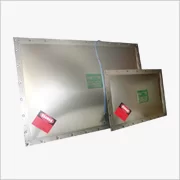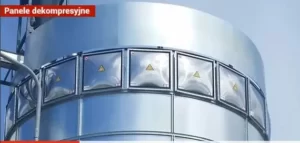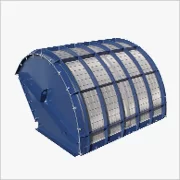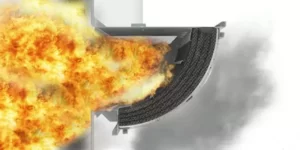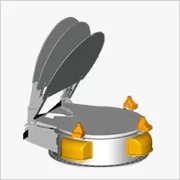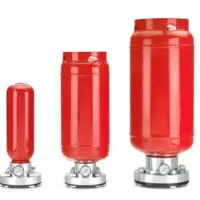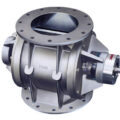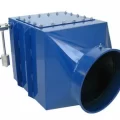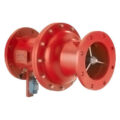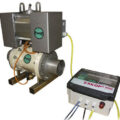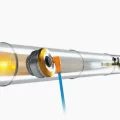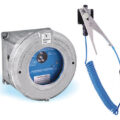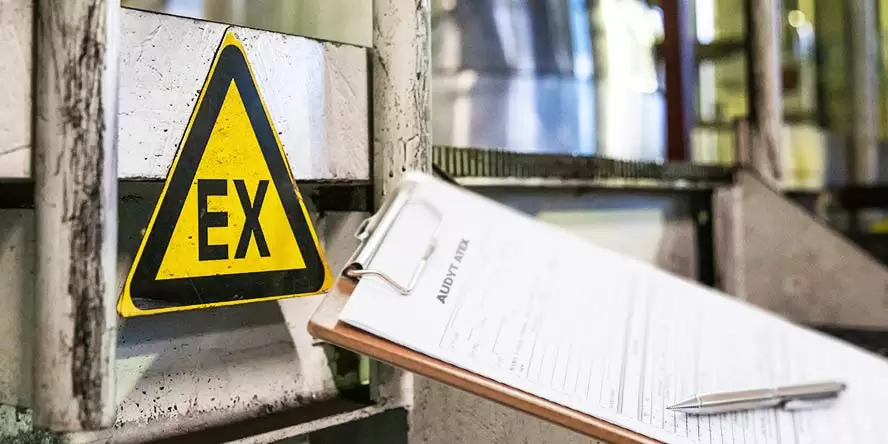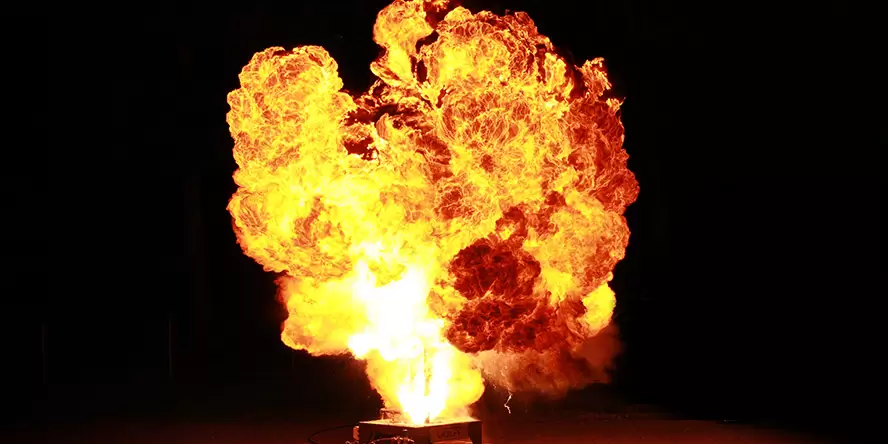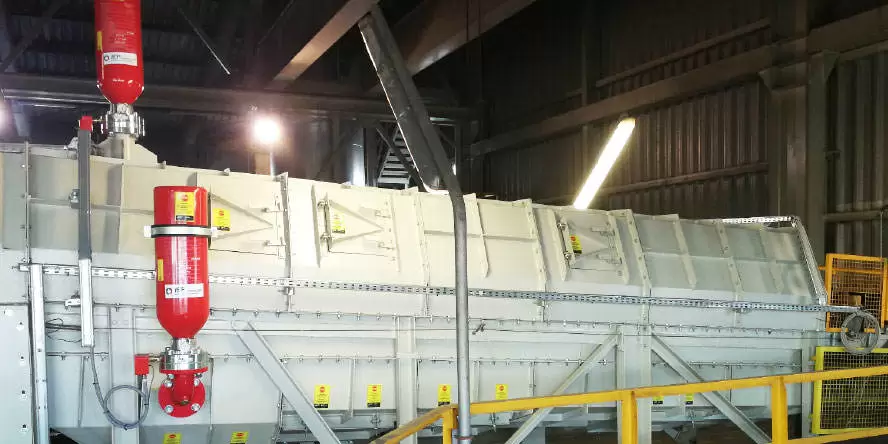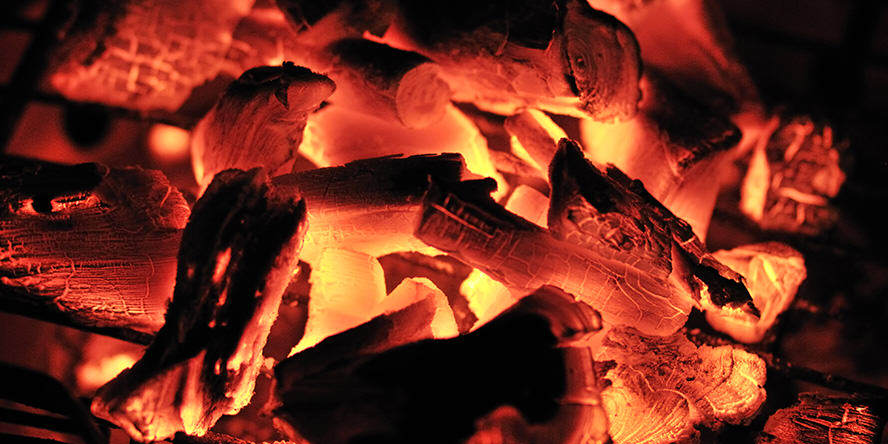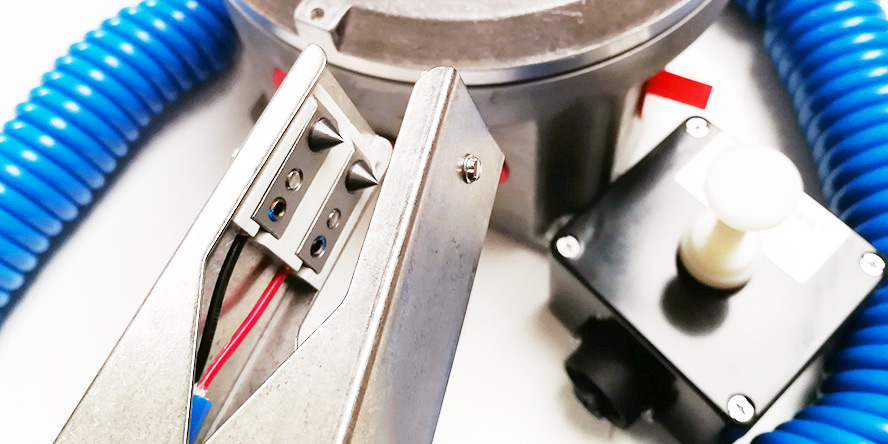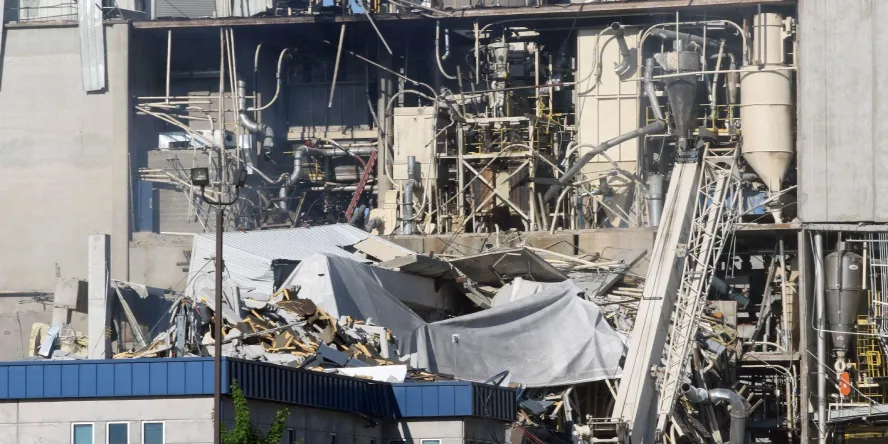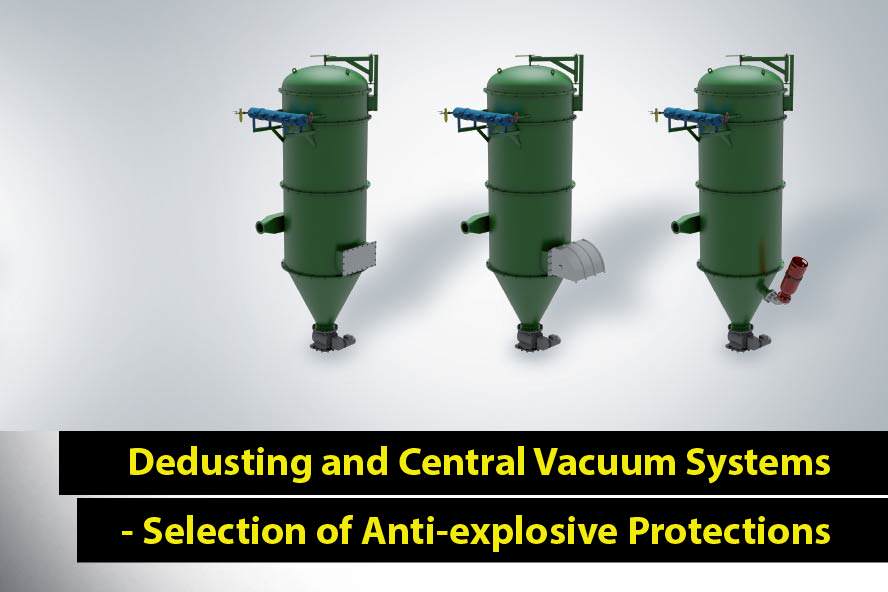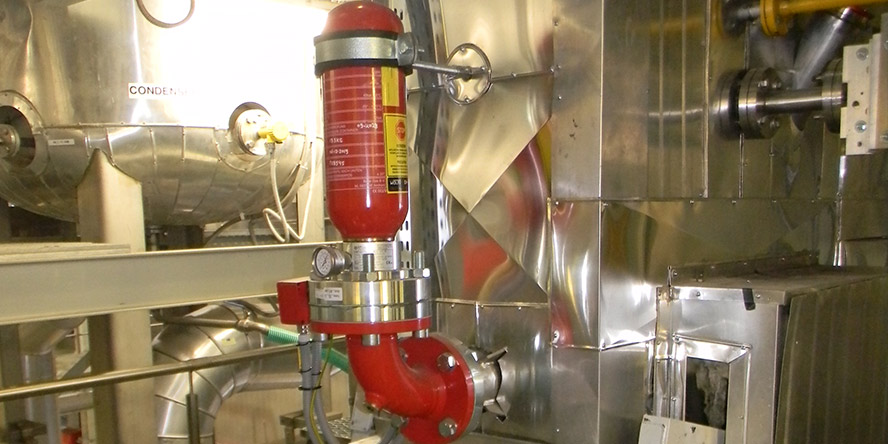What equipment do we protect?
Dust collection
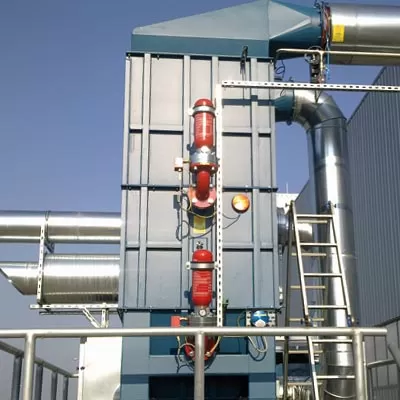
- filters
- cyclones
- cyclone filters
Storage
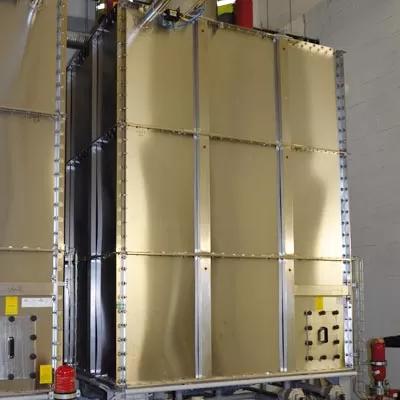
- silos
- hoppers
- tanks
Transport systems
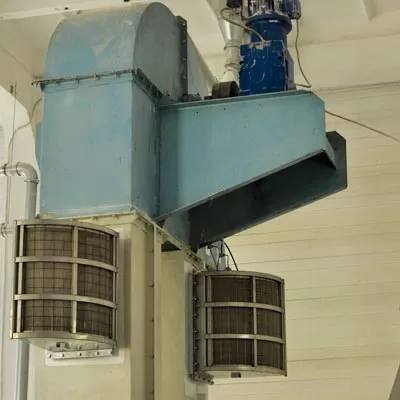
- bucket feeders
- conveyors and belt conveyors
- pipelines
- dumping conveyors
Drying and milling
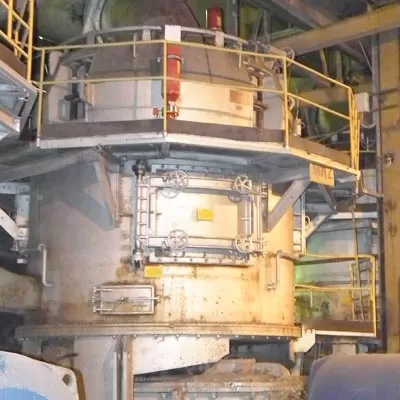
- mills:
- ball mills
- vertical roller mills and other mill types
- dryers:
- spray dryers
- fluid bed dryers and other dryer types
What explosion-proof systems do we design and install?
Explosion relief
Explosion venting is a very effective method of protecting devices and equipment from the effects of an explosion. However, it is very easy for an inexperienced designer to make various mistakes, due to many limitations of various systems. Our designers have selected and designed explosion venting systems for thousands of different devices and pieces of equipment located in industrial plants in Poland and around the world.
Decompression panels
The most affordable protection method for use outside buildings. Flames and pressure are released into the environment (danger to people and equipment). The need to demarcate a danger zone.
Flameless relief
Single-use protection method for indoor and outdoor use. Flames and pressure are NOT released into the environment. Reduced risk of fire in the apparatus after an explosion.
Relief valves
Single-use protection method for indoor and outdoor use. Flames and pressure are NOT released into the environment. Reduced risk of fire in the apparatus after an explosion.
Pressure relief vents
Single-use protection method for indoor and outdoor use. Flames and pressure are NOT released into the environment. Reduced risk of fire in the apparatus after an explosion.
Explosion suppression
Reliable and with no limitations
We also design the most technically advanced (yet reliable and free of limitations inherent in venting systems) explosion suppression systems. Such explosion protection systems require extensive practical experience from their designers – the proper designation of installation locations of HRD cylinders and pressure and flame sensors is key to ensuring reliable and effective explosion protection.
See also:
Explosion containment design
Explosion containment is a legally required, additional safeguard protecting any equipment subject to explosion protection systems. Its purpose is to prevent an explosion from spreading to other equipment and process plant components and open-plan production areas. The design of explosion containment systems is closely related to the equipment to be protected and the venting or suppression systems selected to protect it.
Design of preventive systems
According to the ATEX Directive, the employer, in order to protect property and the health and life of workers, should implement measures to prevent and minimise the effects of an explosion. As part of our comprehensive explosion protection selection and design services, we also implement preventive systems. However, it is important to remember that while preventive measures can significantly reduce the risk of an explosion, they can never completely eliminate it. A similar approach is used in the design of cars that we drive every day. Despite a number of preventive measures such as the ABS system, every car has crash mitigation measures which include air bags, seatbelts or structural reinforcements.
Our completed projects and security concepts
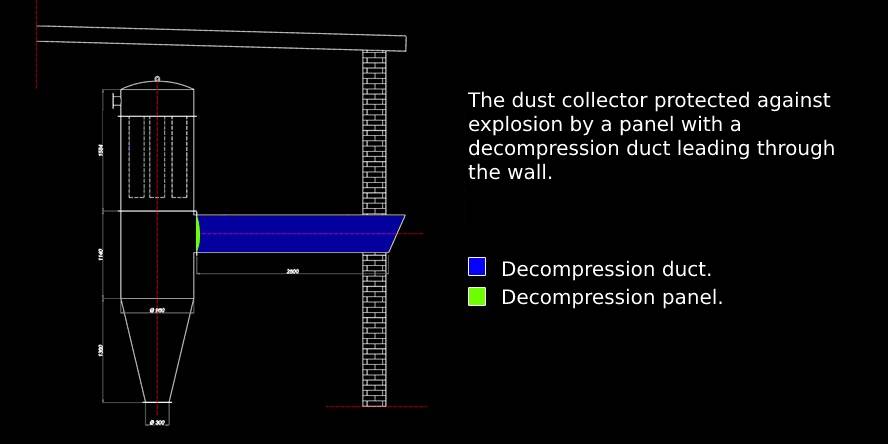
Dust collector in an enclosed space

Spray dryer with dry powder collection facility

Conveyor belt – construction and protection design

Bucket elevators – design and installation of a protection system
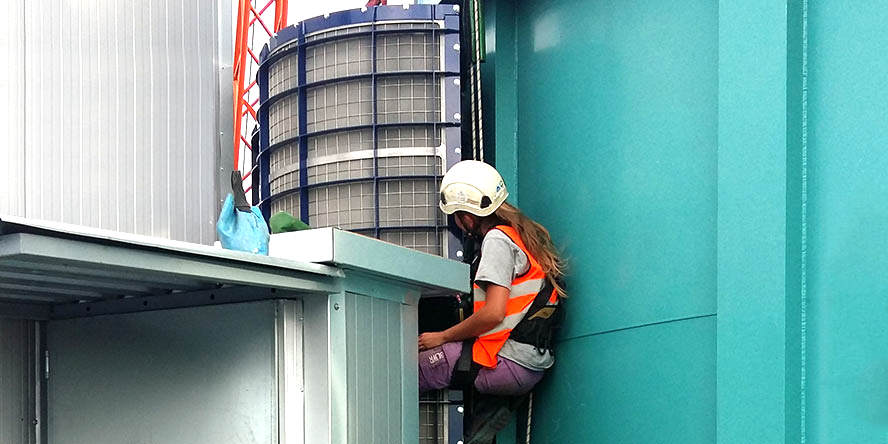
Biomass silo – design and installation of a protection system
Our explosion protection design philosophy
More than just “design”
It is worth clarifying what “design” means to us. It involves not only the preparation of a detailed design consisting of technical drawings of installations to be protected and the necessary safeguards to be installed. At WOLFF GROUP, we take this issue much further, always making the safety of your site a priority.

Different variants of concepts
Before starting design work, we often present different variants of the concept, based on different safeguards…

Design
We implement projects in both newly-built and upgraded facilities. At this stage…

Implementation
Construction and assembly work doesn’t always conform to plan, particularly when performed on active industrial sites. Rapid changes are sometimes required…
Critical points in the design of explosion protection systems
Project owner’s perspective

Risk of incorrect choice of safety measures
Details ▾
Minimising the risk of choosing incorrect safety measures is of critical importance for the project owner. Using improper safeguards are just as dangerous as having no safeguards at all. Ask your supplier for an ATEX Audit and get written confirmation of the risk of explosion at your site, along with proposed means of securing the installation, citing specific legislation and experience from similar implementations.

Risk of calculation errors when designing safety systems
Details ▾
After choosing a specific method of safeguarding your machines and equipment against potential explosions, calculations performed by the supplier are the next critical point in the process. Calculations are required to determine such aspects as the required decompression area for blast vent panels or the location of the HRD cylinder on the pipeline for blast isolation. Errors in calculations will result in improper tripping of the designed safety system. It is therefore imperative to make sure that calculations are performed using certified software and not, for example, using Excel, which can easily lead to mistakes.

Missing or badly designed support structures
Details ▾
Correct calculations using certified software will also indicate whether additional support structures need to be designed. On the one hand, they can increase the structural strength of the protected device (thus reducing, for example, the required decompression area) and, on the other hand, they can help support safeguards that sometimes weigh up to several hundred kilograms, putting a strain on the entire structure of the protected device. Deficiencies or errors at this stage can contribute to catastrophic consequences, not only in the event of an explosion, but also in the normal operation of protected installations.

Deficiencies or errors in adaptor design
Details ▾
The implementation of explosion protection often requires the replacement of some existing machine and equipment components. Unfortunately, they cannot usually be replaced like-for-like. To do this, customised adapters must be designed. Otherwise, the new components purchased will be useless and impossible to fit. An example of this would be replacing cellular dispensers with ones that are certified to act as explosion isolators.

Failure to design electrical and electro-engineering works
Details ▾
A number of electrical and electrical engineering works are required for the correct functioning of many safety features such as explosion suppression, active explosion isolation systems, or in the case of preventive systems such as spark detection and extinguishing. These systems rely on sensors and control panels, which means that in order to design them correctly, all the necessary wiring and the use of switching elements must also be taken into account- all using ATEX-certified components. Remember that the safety system alone is often not the only thing that needs to be designed around the site.

No guidelines for self-installation
Details ▾
Some customers choose to only purchase the safeguards and install them themselves. This is possible, for example, with backflow preventers, decompression panels, flameless explosion relief and other less complex safety features. More often than not, however, the standard installation instructions supplied with the device by the manufacturer are not sufficient to correctly install the security device purchased. As mentioned in the previous sections, additional support structures or adaptors must sometimes be designed. Make sure that the supplier presents individual installation guidelines with the equipment, tailored to the production facilities that you wish to protect.
Why customers choose us
- the project is preceded by a concept with recommendations – this approach will allow you to make an informed decision taking into account all the pros and cons
- we present the advantages and limitations of proposed solutions – there are no solutions without disadvantages, but if you are aware of them, you will be able to choose the optimal solution for your case
- all calculations are performed using certified software – this approach ensures the correct selection of safeguards, taking into account the structural strength of the protected equipment and dust explosion parameters
- we design all the necessary substructures, adapters and electrics – in a nutshell, we perform comprehensive work so that you do not have to use multiple companies and thus witness the often frequent tug-of-war over responsibility for specific actions
- we assemble and commission the systems or let you assemble them – we have our own assembly and service teams, so we can begin assembly as soon as the project is ready. You may decide to install some simple protection systems yourself. We will then provide you with a set of precise installation guidelines taking into account the specifics of your industrial plant
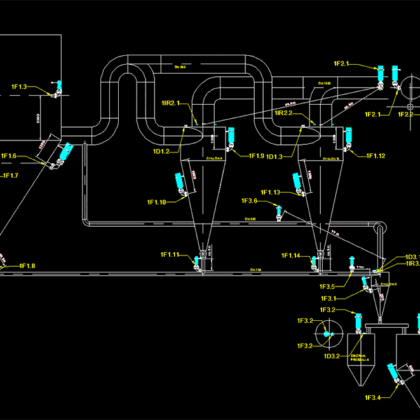
You are protected by our insurance
Only those who do nothing make no mistakes. And while the quality of the work carried out is a priority for us, it is not possible to completely eliminate human error. Unforeseen production stoppages or product contamination during the installation of a system might result in considerable losses. Similarly, a mistake during the design and installation of an explosion protection system can have dire consequences. That is why our insurance policy protects both us and your establishment from unforeseen costs. We have probably the highest insurance policy on the market.
Are you looking for a partner you can trust?
We know that choosing a cooperation partner is a big challenge and responsibility for you. For 30 years, we have completed thousands of tasks in plants in Poland, Europe and remote corners of the world. Thanks to this, we know the requirements, standards and needs of the industry, in particular the wood, energy, food, chemical and pharmaceutical industries.

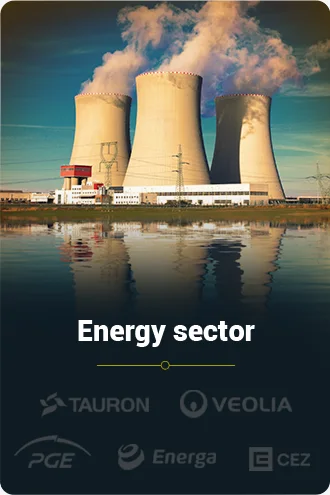

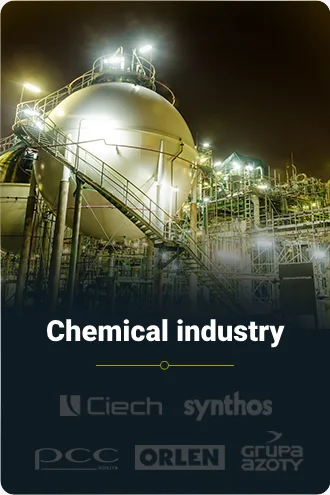

We operate in accordance with the ISO 9001: 2015 quality management system and our own Quality Policy
What happens when each security measure is designed and implemented by a different company?
Over 30 boxes with 220 explosion suppression cylinders of a new type. All to secure a large timber industry plant. This is our third project for the same owner, after doing work in two other plants in Europe. Why did they choose us? The fact that our systems helped contain an explosion in one of the plants operated by our customer was a big factor. It was made possible by our zero compromise approach to security.
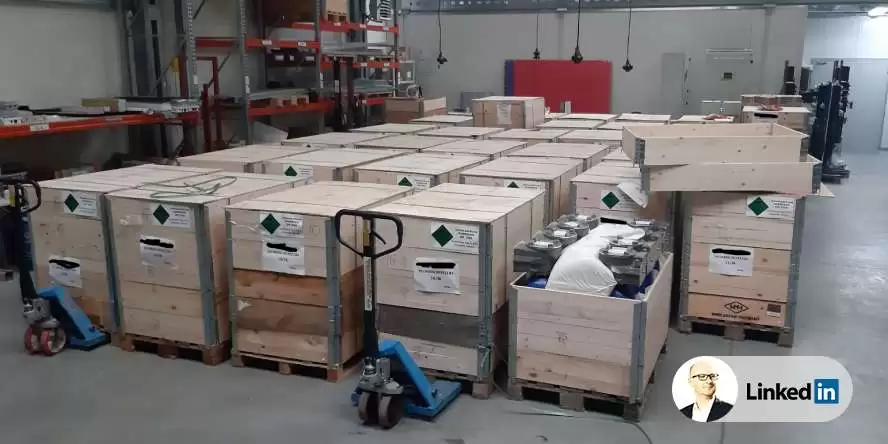
There is a saying that it takes a disaster for a Polish person to wise up. However, when it comes to explosion and fire safety, all nationalities prove to be reckless. The event affected a multinational corporation operating in the wood sector. The aforementioned explosion destroyed a large part of the plant. Losses hit several million. Production was halted. I would be lying if I said that the plant did not have safeguards. It did… Employees were aware of the threat … and acted how they were taught to act and did what they could.
Unfortunately, these measures were doomed to failure from the start…

